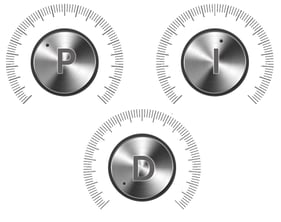You reviewed all important PID loops on your process, and they all seem to work well. You selected some of the loops and followed the tuning procedure to update the PID parameters and with proper tests and models, you managed to apply the known tuning rules so the fast response to SP changes could be achieved. So, there is nothing else to worry about, right? You might have unnoticed some of the loops.
Even though this recipe could be adequate for many of the loops, provided other important criteria are also taken into account, as process objectives, restrictions, and characteristics of actuators, this is not always true, especially for level loops. Two different types of strategies can be distinguished depending on the control objective:
- Strict level loop: it is used to keep the level at the setpoint, bringing the level back to it as fast as possible after disturbances in the incoming flow. This strategy is normally required for boilers and reflux drums.
- Smooth level loop: it is used to absorb the disturbances in the process. The controller must allow the level to move up and down accepting a certain “error” between the PV and the setpoint. Instead of transmitting, or amplifying, the disturbances to the downstream, the level itself should vary accordingly, keeping the variability inside the tank. This is expected for surge tanks and columns.
Wondering how to set the right tuning for level loops? That is what I will explain in this blog.

Finding a good set of parameters
From a control theory point of view, level loops are, or behave likely, integrating process and will have a pole at the origin on the pole-zero map. The response of these systems to a stepwise input would be an ever-increasing output and there is no steady state to which the process will evolve. For this reason, there are important aspects to be considered when applying the tuning recipe to an integrating process.
- The test needs special attention as the tank can easily overflow or dry out if the output and input flows are not correctly paced. In that sense, the test would apply one step up followed by one step down, so to stabilize the system.
- The parameters used for characterizing an integrating process would be the integral gain and time delay. The gain indicates how much the output increases per time unit AND per input unit, (% level/% output/min, for example), and the time delay represents the time between the input change and the first alteration in the output, as observed for self-regulatory processes.
- Choose a PI-action tuning rule. Once the model is known, the tuning rules can be applied. It is noteworthy that only the suitable rules for integrating systems such as Lambda, should be chosen here. Although the non-self regulating process would naturally add the integrate “action” to the response, and a P-only strategy might be an option, the PI-action is still required to prevent loads from bringing offsets to the response. A D-action, though, will not improve the loop performance, especially due to the noisy response often seen in these systems.
- Put the loop in AUTO and change the PID parameters to the new set. It is important to move gradually in the direction of the revised parameters, so to avoid abrupt changes in the response and perform some additional testing to check the level response and de-tune the controller if needed.
The tuning rules will normally result in a tight response for the control loop. That would be desirable for some of the levels, but it will counteract the whole purpose of using a surge tank. Therefore, suitable methods should be used here as, for example, the Zak Friedman’s averaging level rule, which is based on the material balance of the process. The following steps can be followed.
- Define the maximum “common” disturbance FD in the inlet flow. That could be done by observing the plant historic data and finding the larges disturbance during normal operation. As alternative, a 20% of the outlet flow can be used.
- Define the allowed fluctuation in the level LD. That corresponds to the allowed variation in the level from the setpoint when the tank is submitted to the disturbance FD. A safe height, before the alarm limits are reached, should be used here.
- Calculate the controller gain. The P-action is derived from the values LD and the FD chosen and the gain will be set where the outlet flow matches the disturbance at the limit level. That would lead to Kc = FD / LD.
- Calculate the reset time. The I-action is calculated from the residence time of the disturbance (RD), obtained from FD and the volume comprised between the level setpoint and the limit (LD). A hint from the author as a good trade-off between using the surge volume of the vessel and recovering quickly from an upset situation is TI = 4 x RD.
- Put the loop in AUTO and change the PID parameters to the new set gradually. Check the engineering units to have the correct parameters for the control algorithm. Different sets of LD can be used to adjust the controller behaviour if needed.
These two procedures can lead to a set of parameters for both types of level controllers, strict control, and smooth level control. Finding the right set, though, will be challenging and time consuming, especially when some iteration is needed.
Finding the best set of parameters
Tuning level loops can be a demanding activity specially because of its integrating characteristic. A poor tuning set can easily lead to oscillations and dealing with them will be more complicated than for self-regulating loops. Besides, the de-tuning of the parameters found from the conventional rules cannot guarantee that the level constraints are met.
The PID tuning software helps you to find the best set of parameters for each level loop controller. Strict or smooth control, or a combination of both, can be achieved easily by performance and robustness specifications.
The PID tuning software gives you the best loop performance in the shortest time
With the PID tuning software you guarantee that every aspect of the tuning process is considered, when tuning a level loop. From the evaluation of different tuning sets and disturbances, to the automatic conversion of the parameters to the DCS algorithm, the tool finds the best tuning set for your level loop.
Choose a PID tuning software for level loops — you get:
- Fewer interventions during the tuning
- The best responses for both strict and smooth level control
- No oscillations
- More robust tuning
- Better process stability
Read part 2 of this blog. We will explain how all this works on a distillation column.
Do you want to learn more about using AptiTune for level control tuning, ? Request a 30-minute live demo and gain insights into what you can achieve with INCA Tools PID Tuning. It is all you need to get your PID controllers’ algorithm right the first time.




